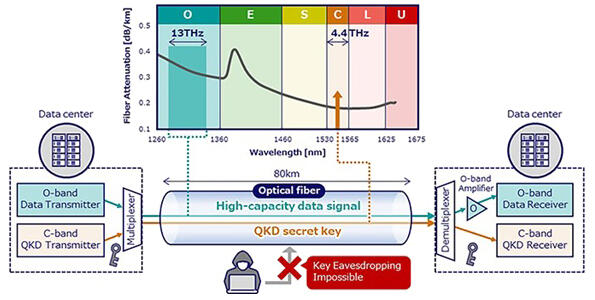KDDI Research, Inc. ("KDDI Research") and Toshiba Digital Solutions Corporation ("Toshiba Digital Solutions") have developed a multiplexing technology for quantum key distribution (QKD) that is theoretically impossible to eavesdrop. This technology assigns secret keys to the C-band and high-volume data signals to the O-band, enabling multiplexed transmission over a single optical fiber. For the first time in the world, they have successfully transmitted secret keys of the QKD method and high-capacity data signals at 33.4 Tbps over a distance of 80 kilometers. This achievement was presented as a technical paper at OFC2025, the world's largest international conference on optical communication technology.

Provided by KDDI Research, Inc.
In the 6G era, the proliferation of AI and IoT is expected to lead to an even more immense and diverse flow of data across networks, making it essential to further increase the transmission capacity of optical fiber communication to support these networks. Additionally, the transmission of highly sensitive information, such as biometric data used in various authentication methods and genomic information necessary for personalized medicine, is anticipated to rise in the future, creating a demand for high-capacity and secure data communication services.
Currently, public key cryptography is employed to protect transmitted data from cyberattacks; however, there are concerns that quantum computers may be able to decrypt this information in the future. As a result, QKD technology, which delivers secure transmission of secret keys, is gaining traction. QKD leverages the principles of quantum mechanics, which state that any attempt at measurement will necessarily change the quantum state, making it possible to detect eavesdropping.
However, technology that utilizes weak light is susceptible to noise generated by nearby wavelengths of light. Consequently, dedicated optical fibers are required for transmitting secret keys utilizing QKD, which poses challenges in terms of implementation and operational costs.
To address this issue, research is being conducted on technologies that multiplex secret keys of the QKD method and data signals over a single optical fiber utilizing different wavelengths. However, achieving both high-capacity data transmission and long-distance communication has proven difficult. This is because increasing the capacity amplifies the noise affecting the secret keys transmitted using the QKD method, while extending the distance exacerbates the impact of noise on the secret keys. Furthermore, KDDI Research has been developing technologies to transmit high-capacity data not only in the widely used C-band (wavelength 1530-1565 nm) and L-band (1565-1625 nm) but also in the ultra-wideband O-band (1260-1360 nm).
In this project, KDDI Research and Toshiba Digital Solutions analyzed and evaluated the impact of data signals transmitted in the O-band on the secret keys transmitted utilizing the QKD method in the C-band. They optimized the optical power and bandwidth for O-band transmission and identified parameters for appropriate amplification of the O-band data signals with an amplifier after transmission. As a result, multiplexed transmission of secret keys using the QKD method was performed in the C-band, which has minimal transmission loss, and multiplexed transmission of high-capacity data signals was performed over the ultra-wide O-band. This enabled successful transmission of both the secret keys of the QKD method and high-capacity data signals at 33.4 Tbps over 80 km utilizing a single optical fiber.
This breakthrough increased the transmission capacity to approximately three times compared to conventional technology. Additionally, it enhanced the transmission performance index by approximately 2.4 times, measured as the product of transmission capacity and distance (capacity-distance product), compared to conventional technology.
This article has been translated by JST with permission from The Science News Ltd. (https://sci-news.co.jp/). Unauthorized reproduction of the article and photographs is prohibited.




